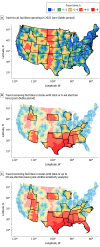Estimated Travel Time and Spatial Access to Abortion Facilities in the US Before and After the Dobbs v Jackson Women's Health Decision
- PMID: 36318194
- PMCID: PMC9627517
- DOI: 10.1001/jama.2022.20424
Estimated Travel Time and Spatial Access to Abortion Facilities in the US Before and After the Dobbs v Jackson Women's Health Decision
Abstract
Importance: Abortion facility closures resulted in a substantial decrease in access to abortion care in the US.
Objectives: To investigate the changes in travel time to the nearest abortion facility after the Dobbs v Jackson Women's Health Organization (referred to hereafter as Dobbs) US Supreme Court decision.
Design, setting, and participants: Repeated cross-sectional spatial analysis of travel time from each census tract in the contiguous US (n = 82 993) to the nearest abortion facility (n = 1134) listed in the Advancing New Standards in Reproductive Health database. Census tract boundaries and demographics were defined by the 2020 American Community Survey. The spatial analysis compared access during the pre-Dobbs period (January-December 2021) with the post-Dobbs period (September 2022) for the estimated 63 718 431 females aged 15 to 44 years (reproductive age for this analysis) in the US (excluding Alaska and Hawaii).
Exposures: The Dobbs ruling and subsequent state laws restricting abortion procedures. The pre-Dobbs period measured abortion access to all facilities providing abortions in 2021. Post-Dobbs abortion access was measured by simulating the closure of all facilities in the 15 states with existing total or 6-week abortion bans in effect as of September 30, 2022.
Main outcomes and measures: Median and mean changes in surface travel time (eg, car, public transportation) to an abortion facility in the post-Dobbs period compared with the pre-Dobbs period and the total percentage of females of reproductive age living more than 60 minutes from abortion facilities during the pre- and post-Dobbs periods.
Results: Of 1134 abortion facilities in the US (at least 1 in every state; 8 in Alaska and Hawaii excluded), 749 were considered active during the pre-Dobbs period and 671 were considered active during a simulated post-Dobbs period. Median (IQR) and mean (SD) travel times to pre-Dobbs abortion facilities were estimated to be 10.9 (4.3-32.4) and 27.8 (42.0) minutes. Travel time to abortion facilities in the post-Dobbs period significantly increased (paired sample t test P <.001) to an estimated median (IQR) of 17.0 (4.9-124.5) minutes and a mean (SD) of and 100.4 (161.5) minutes. In the post-Dobbs period, an estimated 33.3% (sensitivity interval, 32.3%-34.8%) of females of reproductive age lived in a census tract more than 60 minutes from an abortion facility compared with 14.6.% (sensitivity interval, 13.0%-16.9%) of females of reproductive age in the pre-Dobbs period.
Conclusions and relevance: In this repeated cross-sectional spatial analysis, estimated travel time to abortion facilities in the US was significantly greater in the post-Dobbs period after accounting for the closure of abortion facilities in states with total or 6-week abortion bans compared with the pre-Dobbs period, during which all facilities providing abortions in 2021 were considered active.
Conflict of interest statement
Figures



Comment in
-
Abortion bans and their impacts: A view from the United States.Cell Rep Med. 2023 Jan 17;4(1):100905. doi: 10.1016/j.xcrm.2022.100905. Cell Rep Med. 2023. PMID: 36652914 Free PMC article.
Comment on
-
The A Word-Our Collective Scarlet Letter.JAMA Surg. 2023 Feb 1;158(2):116-118. doi: 10.1001/jamasurg.2022.6638. JAMA Surg. 2023. PMID: 36318202 No abstract available.
References
-
- Dobbs v Jackson Women’s Health Organization_ US _ (June 24, 2022). Accessed October 25, 2022. https://www.supremecourt.gov/opinions/21pdf/19-1392_6j37.pdf
-
- McCann A, Walker AS, Sasani A, Johnston T, Buchanan L, Huang J. Tracking the states where abortion is now banned. New York Times. Updated September 30, 2022. Accessed October 13, 2022. https://www.nytimes.com/interactive/2022/us/abortion-laws-roe-v-wade.html
-
- Jerman J, Jones RK, Onda T. Characteristics of US abortion patients in 2014 and changes since 2008. Guttmacher Institute. May 2016. Accessed October 24, 2022. https://www.guttmacher.org/report/characteristics-us-abortion-patients-2014
Publication types
MeSH terms
LinkOut - more resources
Full Text Sources
Medical

